- Submissions

Full Text
Archaeology & Anthropology:Open Access
Archean Mafic-Ultramafic Ikauna Layered Intrusion, Bundelkhand Craton, India: Petrography and Geochemistry
Alexander Slabunov1, Svetlana Egorova1, Vinod K Singh2*, Sergei Svetov1 and Santosh Kumar3
1 Institute of Geology, Karelian Research Centre, Russia
2 Department of Geology, Bundelkhand University, India
3 Department of Geology, Kumaon University, India
*Corresponding author: Vinod K Singh, Department of Geology, Bundelkhand University, India
Submission: July 02, 2018;Published: September 25, 2018

ISSN: 2577-1949 Volume3 Issue2
Abstract
The mafic-ultramafic Ikauna intrusion is a well-differentiated complex comprising dunite (serpentinite), pyroxenite, gabbro and gabbro-pegmatite in southern part of the Bundelkhand craton. The metagabbro samples are characterized by Rb and Ba enrichment and positive Sr and Eu anomalies, as would be expected for the presence of cumulus plagioclase. The meta-dunites and metapyroxenites are marked by lower trace element abundances than the metagabbros and negative Sr anomalies, which might be related to fractional crystallization of plagioclase. The compositional characteristics of the Ikauna intrusion rocks discussed suggest that they are comparable with the layered intrusions of the peridotite-gabbronorite complex characteristic of the Karelian craton.
Keywords: Archean; layered intrusion; Bundelkhand craton; Mafic-ultramafic
Introduction
Figure 1:Geological map of Madawara-Girar area and Ikauna dunite-pyroxenite-gabbro layered complex (intrusion) location [12,14].
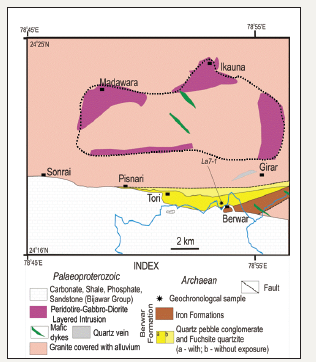
Bundelkhand craton is a protocontinent situated in the center of Indian shield, covers about 29000 km2 areas and constitute acid granitoid complex with lesser amount of metasedimentary, meta basics, with low grade metamorphics of the older crust and quartz veins. The Bundelkhand craton is mostly preserved 3.5-2.5Ga granitoids and granite–greenstone terrane [1-7]. The trough/graben and surrounding basins of Bundelkhand craton were filled by thick pile of Bijawar and Vindhyan sediments during Proterozoic times. The craton is seldom studied and its stabilization period was at the end of Archean eon with voluminous granitic magmatism at around 2.5Ga in the Earth’s evolutionary history. Singh and Slabunov [5,8] reported two greenstone complexes in the Bundelkhand craton. First is the Central Bundelkhand greenstone complex (CBGC), consisting of Babina and Mauranipur greenstone belts, with exposed rocks of TTG and granitoids, mafic–ultramafic, felsic volcanics, minor metasedimentary, and high-K granites [5,6,9]. The second is the Southern Bundelkhand schist complex comprising Girar and Berwar belt. It is occurring small isolated outcrops of quartzite, BIFs, ultramafic rocks. The less studied layered igneous intrusions occurring in southern Bundelkhand craton around Madawara to Ikauna [10-14]. Slabunov et al. [15] indicate that the craton is significance by last endogenic activity at Paleoproterozoic (1.9-1.8Ga) create quartz veins, generally display along NE-SW trend. The major lithounits of the Bijawar region are divided in to Mehroni and Mandawra group and detail stratigraphy is given in the Table 1 [16]. The present paper consists to Ikauna Layered Igneous Intrusive complex which form a part of the Southern portion of the Bundelkhand craton. It is located around Madawara to Ikauna regions of Lalitpur district, Uttar Pradesh (Figure 1).
Geology of Mafic-Ultramafic Ikauna Complex
The general geology of southern Bundelkhand craton has been discussed in detail by Singh and Slabunov [13]. In the southern Bundelkhand craton lies a large (15 by 6km) poorly studied intrusion, presumably a lopolith (Figure 1), known as the Ikauna Complex. The Madawara-Ikauna terrain comprises peridotite, harzburgite, serpentinite, pyroxenites and associated diorite and gabbro. Disseminated lensoidal exposures of these rocks are occurring around the Madawara areas for more than 400sq. km in the Southern part of the craton [10-14]. Figure 2 show the different kind of rock exposures of serpentinite, metagabbro, gabbro-pegmatite and Neoarchean pink granite intrusion in gabbroic rocks exposed around Ikauna area. This mafic-ultramafic rocks lie among Archean rocks of Bundelkhand granitoids, Rajaula Formation and apparently cut them, which determine the lower levels of their age. There are indirect, the demanding checks, data that rocks of Ikauna Complex cut by Neoarchean pink granite (Figure 2) and Paleoproterozoic doleritic dykes, that defines upper levels of their age. Thus, the geological ages of this mafic-ultramafic complex are Archean.
Figure 2:Photos of Ikauna dunite-pyroxenite-gabbro layered complex rocks in outcrops:
a) Serpentinite (Metadunite) with relict of panautomorphic texture in Madawara (scale on compass-in cm);
b) Metagabbro in canal near Ikauna (scale on compass-in cm).
c) Gabbro-pegmatite veins in gabbro (compass-10 cm).
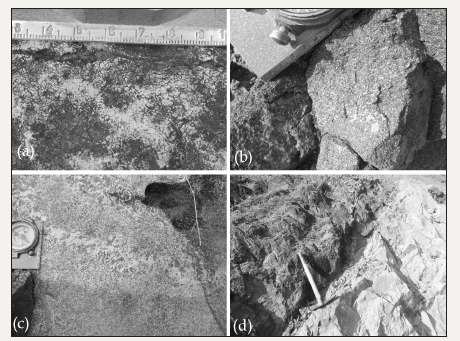
Table 1:Stratigraphy of Madawara Block, Lalitpur Disrtict, Uttar Pradesh [12,16].
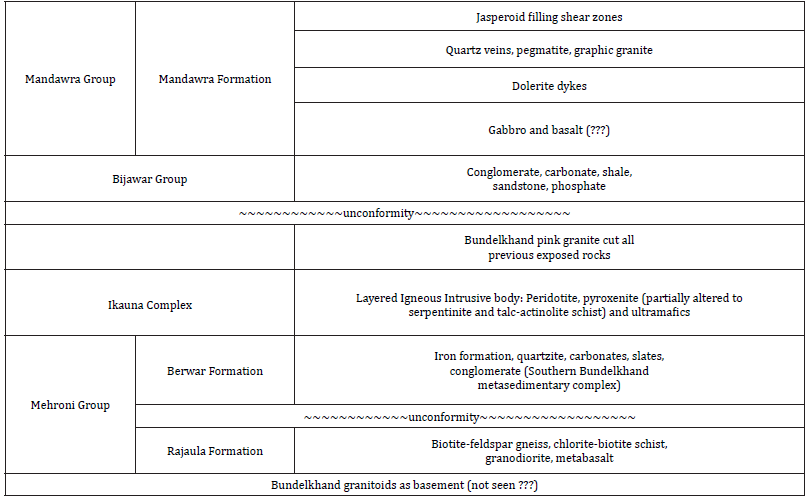
Petrography and Chemical Composition
Table 2:Major (wt.%) and trace (ppm) element analytical data of Ikauna complex, Bundelkhand craton, India.
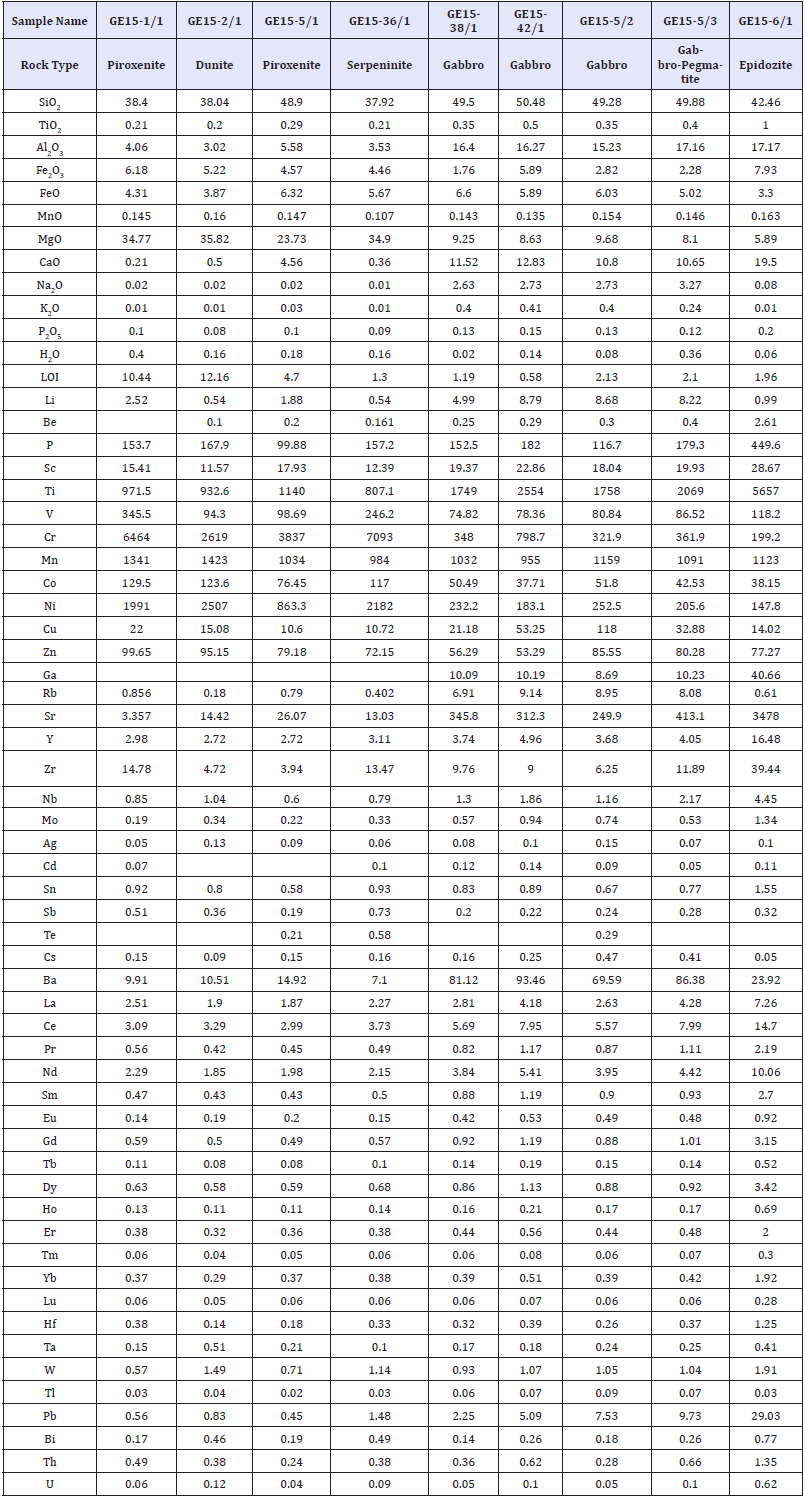
The mafic-ultramafic Ikauna intrusion is a well-differentiated complex and its petrographic characteristics show essential minerals of serpentine, amphiboles, plagioclase, tremolite–actinolite and chlorite which comprising dunite (serpentinite) (Figure 3(a-b)), pyroxenite, gabbro (Figure 3(c-d)) and gabbro-pegmatite. Ikauna intrusive rocks vary considerably in composition (Table 2). The dunite contains high MgO (39.14-41.02wt.%), Cr (2619-7093ppm), Ni (1991-2507ppm) and low SiO2 (43.17-43.56wt.%), Al2O3 (3.46-4.57wt.%), CaO (0.24-0.57wt%) and alkali concentrations (Na2O+K2O=0.02 to 0.03wt.%). The gabbro and gabbro-pegmatite have lower MgO (8.26-9.86wt.%), Cr (799ppm) and Ni (252ppm) and higher SiO2 (50.18 wt.% in gabbro and 51.02wt.% in gabbro- pegmatite), Al2O3 (15.51-17.55wt.%), CaO (10.89-12.28wt.%) and alkali concentrations (Na2O+K2O=3.0 to 3.59wt.%) than Ikauna intrusion dunites. The position of the points of compositions of Ikauna intrusive rocks on the TAS (SiO2-Na2O+K2O) classification diagram (Figure 4a) [17] for plutonic rocks and in the AFM diagram (Figure 4b) [18] allow to define them as ultrabasic and basic rocks mainly tholeiitic series. Same fields on these diagrams are characteristic for typical mafic-ultramafic Paleoproterozoic layered intrusions of the Karelian craton (Figure 5). Ni and Cr increases with increasing MgO, consistent with the accumulation of olivine and chromite.
SiO2, Al2O3 and CaO increase with decreasing MgO, consistent with the accumulation of clinopyroxene and plagioclase in gabbro (Figure 5). Similar rock composition variations trends are characteristic of the Paleoproterozoic layered intrusions of the Karelian craton, e.g. the Kivakka massif [19]. Ikauna intrusion rocks are characterized by a slight enrichment in LREE ((La/Sm)n=1.8-3.3) and largely unfractionated or a slight depletion in HREE ((Gd/Yb) n=1.1-2). In addition, samples from the metagabbro display a positive Eu anomaly (Figure 6) [20]. The REE patterns of different types of rocks in the Ikauna intrusion have sub-parallel trends, suggesting that the different rock types are related to each other by differentiation of the same primary magma. The trace element abundanc es and patterns for the different types of rocks in the intrusion are variable. The metagabbro samples are characterized by Rb and Ba enrichment and positive Sr and Eu anomalies, as would be expected for the presence of cumulus plagioclase. The metad unites and metapyroxenites are marked by lower trace element abundances than the metagabbros and negative Sr anomalies, which might be related to fractional crystallization of plagioclase. The compositional characteristics of the Ikauna intrusive rocks discussed and suggest that they are comparable with the layered intrusions of the peridotite-gabbronorite complex characteristic of the Karelian craton [13,14].
Figure 3:Petrography of Ikauna dunite-pyroxenite-gabbro layered complex rocks:
Figure 3(a-b): Photomicrographs of Metadunite (serpentinite).
Figure 3(c-d): Gabbro (polarized light (a, c) and cross nicol (b, d)).
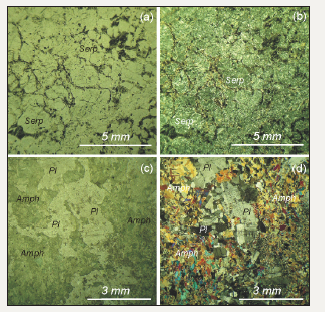
Figure 4:Classification diagram
Figure 4a: TAS (SiO2 - Na2O + K2O) [17].
Figure 4b: AFM diagram [18] for Ikauna intrusion (Bundelkhand craton, India) and Kivakka (Karelian craton, Russia) layered intrusion.
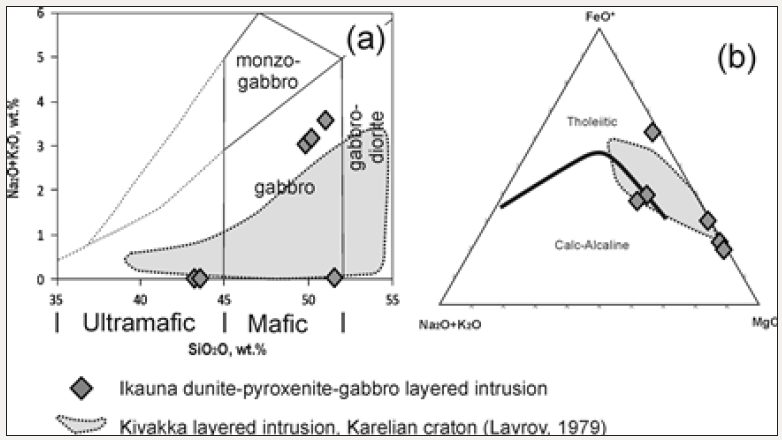
Figure 5:Variations in major element vs MgO in Ikauna (Bundelkhand craton) and Kivakka (Karelian craton) layered complexes.
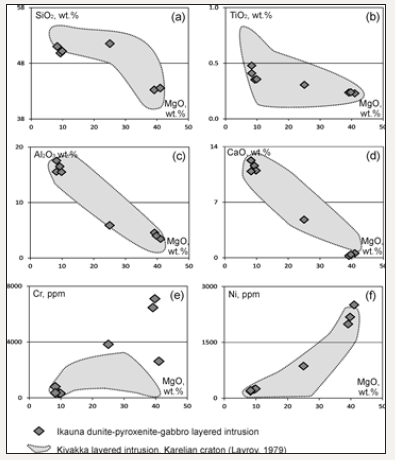
Figure 6:Chondrite-normalized REE [20] patterns in Ikauna layered complex.
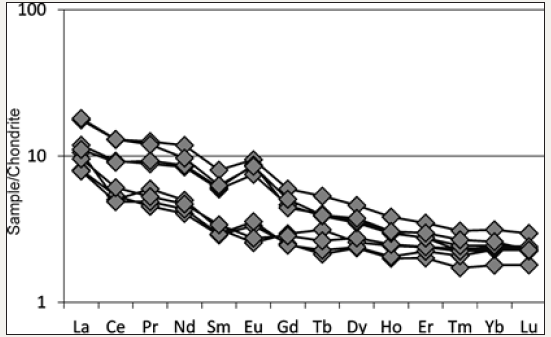
Acknowledgement
We are highly thanks for RFBR (17-55-45005 IND) and DST (INT/RUS/RFBR/P-279) grants for financial support. This work is supported under MOU between Bundelkhand University, Jhansi, India and Institute of Geology, Karelian Research Centre, RAS, Petrozavodsk, Russia.
References
- Basu AK (1986) Geology of parts of the Bundelkhand granite massif, Central India. Records Geol Surv, India, pp. 61-124.
- Kaur P, Zeh A, Chaudhri N, Eliyas N (2016) Unravelling the record of Archean crustal evolution of the Bundelkhand Craton, northern India using U-Pb zircon-monazite ages, Lu-Hf isotope systematics, and wholerock geochemistry of granitoids. Precambrian Research 281: 384-413.
- Mondal MEA, Goswami JN, Deomurari MP, Sharma KK (2002) Ion microprobe 207Pb/206Pb ages of zircons from the Bundelkhand massif, northern India: implications for crustal evolution of the Bundelkhand- Aravalli protocontinent. Precambrian Research 117(1-2): 85-100.
- Saha L, Frei D, Gerdes A, Pati JK, Sarkar S, et al. (2016) Crustal geodynamics from the Archean Bundelkhand Craton, India: constraints from zircon U-Pb-Hf isotope studies. Geological Magazine 153(1): 179- 192.
- Singh VK, Slabunov A (2015) The central Bundelkhand Archean greenstone complex, Bundelkhand craton, central India: geology, composition, and geochronology of supracrustal rocks. Int Geol Rev 57: 1349-1364.
- Slabunov AI, Singh VK (2017) Central Bundelkhand greenstone complex of the Bundelkhand Craton, India: new geochronological data, a geodynamic setting and the position of the craton in the Kenorland Supercontinent structure. In: Slabunov AI, Svetov SA, Baltibaev ShK (Eds.), Early Precambrian vs. Modern Geodynamics, Extended abstracts and Field Trip Guide, Kar RC RAS, Petrozavodsk, Russia, pp. 235-238.
- Verma SK, Verma SP, Oliveira EP, Singh VK, Moreno JA (2016) LA-SFICP- MS zircon U-Pb geochronology of granitic rocks from the central Bundelkhand greenstone complex, Bundelkhand craton, India. Journal of Asian Earth Sciences 118: 125-137.
- Singh VK, Slabunov AI (2013) The greenstone belts of the Bundelkhand craton, Central India: New geochronological data and geodynamic setting. In: Singh VK, Chandra R (Eds.), International Association for Gondwana research Conference Series, 3rd International conference Precambrian Continental Growth and Tectonism, Jhansi, India, pp. 170- 171.
- Singh VK, Slabunov A (2015) Geochemical characteristics of banded iron Formation and Metavolcanics of Babina greenstone belt of the Bundelkhand Craton, Central India. J Econ Geol Georesource Manage 10: 63-74.
- Faroqui SA, Singh AK (2006) Platinum mineralizationin the Ikaunaarea, Lalitpur District, Uttar Pradesh. Journal of Geological Society of India 68(4): 582-584.
- Faroqui SA, Singh PK (2010) PGE Mineralisation in the ultramafic/mafic enclaves of the Ikauna area. In: Satake K (Ed.), Advances in Geosciences, Solid Earth, India 20: 111-120.
- Singh VK, Slabunov AI (2016) Two types of Archaean supracrustal belts in the Bundelkhand Craton, India: Geology, geochemistry, age and implication for craton crustal evolution. Journal of the Geological Society of India 88(5): 539-548.
- Slabunov A, Egorova S, Singh VK (2016) Ikauna complex of the Bundelkhand Craton as a dunite-pyroxenite-gabbro layered intrusion: geochemistry and comparison with analogues from the Karelian Craton. An International Conference on Recent Advances in Material and Chemical Sciences. Abstract Book. Bundelkhand University. Jhansi, India, p. 50.
- Slabunov A, Singh VK, Joshi KB, Li X (2017) Paleoarchean zircons from quartzite of South Bundelkhand Supracrustal Complex: origin and implications for crustal evolution in Bundelkhand Craton, Central India. Current Science 112(4): 794-801.
- Slabunov AI, Singh VK, Shchiptsov VV, Lepekhina EN (2017) A new Paleoproterozoic (1.9-1.8Ga) event in the crustal evolution of the Bundelkhand Craton, India: The results of (SHRIMP) Dating of zircons from giant quartz veins. In: Slabunov AI, Svetov SA, Baltibaev ShK (Eds.), Early Precambrian vs Modern Geodynamics. Extended Abstracts and Field Trips Guide. Kar RC RAS, Petrozavodsk, Russia, pp. 239-241.
- Prakash R, Singh JN, Saxena PN (1975) Geology and mineralization in the southern parts of Bundelkhand in Lalitpur. Journal of the Geological Society of India 16(2): 143-156.
- Cox KG, Bell JD, Pankhurst RJ (1979) The interpretation of igneous rocks. Boston, George Allen and Unwin London, UK, p. 450.
- Irvine TN, Barager WRA (1971) A guide to the chemical classification of the common volcanic rocks. Canadian Journal of Earth Sciences 8: 523- 548.
- Lavrov ММ (1979) Hyperbasic rocks and the Precambrian layered peridotite-gabbronorite intrusions of North Karelia. Nauka, Russia, p. 136.
- McDonough WF, Sun S (1995) The Composition of the earth. Chemical Geology 120(3-4): 223-253.
© 2018 Vinod K Singh. This is an open access article distributed under the terms of the Creative Commons Attribution License , which permits unrestricted use, distribution, and build upon your work non-commercially.
 a Creative Commons Attribution 4.0 International License. Based on a work at www.crimsonpublishers.com.
Best viewed in
a Creative Commons Attribution 4.0 International License. Based on a work at www.crimsonpublishers.com.
Best viewed in 







.jpg)






























 Editorial Board Registrations
Editorial Board Registrations Submit your Article
Submit your Article Refer a Friend
Refer a Friend Advertise With Us
Advertise With Us
.jpg)






.jpg)














.bmp)
.jpg)
.png)
.jpg)










.jpg)






.png)

.png)



.png)






